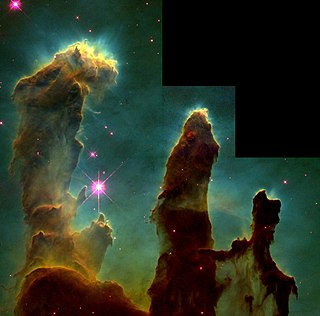 W
W"Space art" is the term for a genre of modern artistic expression that strives to show the wonders of the Universe. Like other genres, Space Art has many facets and encompasses realism, impressionism, hardware art, sculpture, abstract imagery, even zoological art. Though artists have been making art with astronomical elements for a long time, the genre of Space Art itself is still in its infancy, having begun only when humanity gained the ability to look off our world and artistically depicted what we see out there. Whatever the stylistic path, the artist is generally attempting to communicate ideas somehow related to space, often including an appreciation of the infinite variety and vastness which surrounds us. In some cases, artists who consider themselves Space Artists use more than illustration and painting to communicate scientific discoveries or works depicting space, some have had the opportunity to work directly with space flight technology and scientists in attempts to expand the arts, humanities, and cultural expression relative to space exploration.
 W
WAstronomical art is the aspect of Space art devoted to visualizing the wonders of outer space. A major emphasis of such art is the space environment as a new frontier for Humanity. Many other works portray alien worlds, extremes of matter such as black holes, and concepts arising from inspiration derived from astronomy.
 W
WAstrophotography, also known as astronomical imaging, is photography of astronomical objects, celestial events, and areas of the night sky. The first photograph of an astronomical object was taken in 1840, but it was not until the late 19th century that advances in technology allowed for detailed stellar photography. Besides being able to record the details of extended objects such as the Moon, Sun, and planets, astrophotography has the ability to image objects invisible to the human eye such as dim stars, nebulae, and galaxies. This is done by long time exposure since both film and digital cameras can accumulate and sum light photons over these long periods of time.
 W
WThe Sciencenter's Sagan Planet Walk is a walkable scale model of the Solar System, located in Ithaca, New York. The model scales the entire Solar System—both planet size and distances between them—down to one five billionth of its actual size. The exhibition was originally created in 1997 in memory of Ithaca resident and Cornell Professor Carl Sagan.
 W
WThe Somerset Space Walk is a sculpture trail model of the Solar System, located in Somerset, England. The model uses the towpath of the 22-kilometre (14-mile) Bridgwater and Taunton Canal to display a model of the Sun and its planets in their proportionally correct sizes and distances apart. Unusually for a Solar System model, there are two sets of planets, so that the diameter of the orbits is represented.
 W
WA star trail is a type of photograph that uses long exposure times to capture the apparent motion of stars in the night sky due to Earth's rotation. A star-trail photograph shows individual stars as streaks across the image, with longer exposures yielding longer arcs.
 W
WThe Sweden Solar System is the world's largest permanent scale model of the Solar System. The Sun is represented by the Ericsson Globe in Stockholm, the largest hemispherical building in the world. The inner planets can also be found in Stockholm but the outer planets are situated northward in other cities along the Baltic Sea. The system was started by Nils Brenning and Gösta Gahm and is on the scale of 1:20 million.